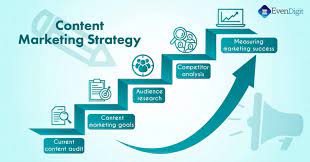Introduction
In the digital age, content marketing has become a cornerstone of successful online business strategies. Creating and distributing valuable, relevant, and consistent content not only engages your target audience but also builds brand awareness and loyalty. This article explores effective content marketing strategies that can elevate your brand’s online presence and drive meaningful results.
Create Buyer Personas
Before crafting content, it’s crucial to understand your audience. Develop detailed buyer personas representing your ideal customers. Consider demographics, interests, pain points, and online behaviors. This insight will guide your content creation, ensuring it resonates with the right people in a way that speaks to their needs and preferences.
Conduct Audience Research Regularly
Audience preferences evolve, so ongoing research is essential. Use analytics tools, surveys, and social media insights to understand changing trends, behaviors, and preferences. Stay agile in your approach, adapting your content to address the shifting needs of your audience.
Define Measurable Objectives
Establish clear goals for your content marketing efforts. Whether it’s increasing brand awareness, driving website traffic, or boosting conversions, having specific and measurable objectives provides direction. Align your content strategy with overarching business goals to ensure a cohesive and purpose-driven approach.
Use KPIs to Track Success
Identify key performance indicators (KPIs) that align with your goals. Track metrics such as website traffic, engagement rates, conversion rates, and social media metrics. Regularly analyze performance data to gauge the effectiveness of your content and make data-driven adjustments to optimize results.
Focus on Quality Over Quantity
In the saturated online space, quality trumps quantity. Create content that provides real value to your audience. Whether it’s informative blog posts, engaging videos, or interactive infographics, prioritize substance and relevance. High-quality content not only attracts but retains and converts your audience.
Leverage Different Content Formats
Diversify your content formats to cater to different audience preferences. Mix written content with visuals, videos, podcasts, and interactive elements. This approach not only keeps your content strategy fresh and interesting but also accommodates various learning styles and consumption habits.
Conduct Keyword Research
Integrate SEO into your content strategy by conducting thorough keyword research. Identify relevant keywords that align with your business and resonate with your audience. Incorporate these keywords strategically in your content, including titles, headings, and body copy, to enhance search engine visibility.
Create Engaging Meta Descriptions
Craft compelling meta descriptions that encourage users to click through to your content. While meta descriptions don’t directly impact search rankings, they play a crucial role in attracting clicks from search engine result pages. Use concise and persuasive language to entice users to explore your content.
Maintain a Consistent Brand Voice
Consistency in branding and messaging fosters brand recognition and trust. Define and maintain a consistent brand voice across all your content channels. Whether it’s blog posts, social media updates, or email campaigns, ensure that your brand personality shines through, creating a unified and memorable experience for your audience.
Tell a Cohesive Brand Story
Craft a cohesive brand story that resonates with your audience. Your content should reflect your brand’s values, mission, and unique selling propositions. A compelling brand story creates an emotional connection with your audience, fostering loyalty and differentiation in a competitive landscape.
Encourage Two-Way Communication
Effective content marketing goes beyond broadcasting messages – it involves creating conversations. Encourage audience participation through comments, shares, and discussions. Respond promptly to comments and messages, showing that you value and appreciate your audience’s engagement.
Run Interactive Campaigns and Polls
Run interactive campaigns and polls to involve your audience actively. Whether it’s a social media poll, a contest, or a user-generated content initiative, interactive elements enhance engagement and make your audience feel like an integral part of your brand’s story.
Leverage Social Media Platforms
Social media is a powerful vehicle for content distribution. Identify the platforms where your audience is most active and tailor your content for each channel. Use a mix of organic and paid strategies to maximize reach and engagement.
Utilize Email Marketing Effectively
Email remains a potent tool for content distribution. Build and segment your email list to deliver targeted content to specific audience segments. Craft compelling subject lines and personalized content to increase open rates and drive traffic to your website.
Conclusion
Effective content marketing requires a strategic and audience-centric approach. By understanding your audience, setting clear goals, creating valuable content, optimizing for SEO, maintaining consistent branding, engaging with your audience, and leveraging multiple channels for promotion, you can build a robust content marketing strategy that resonates with your target audience and achieves meaningful results. Stay agile, adapt to changing trends, and continuously analyze data to refine and optimize your approach for sustained success.

